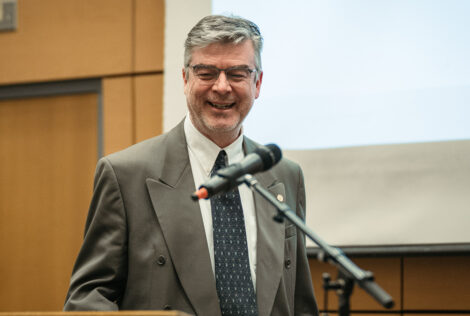
Expertise
Areas of Specialization
Research Clusters
-
Professor
Chemical Engineering
Overview
The research interests of my group are primarily focused around extrusion machinery, whether the process of study serves the plastics, pharmaceutical or functional foods industries, and some particle processing technologies such as spray drying. Through experiments and modelling, knowledge and software tools are being produced to assist these industrial sectors in controlling or developing their processes. We are particularly interested in controlling the morphology of novel material systems in order to achieve desired product specifications.
Current Areas of Research
- Granulation extrusion – particle design by wet or dry processes for pharmaceutical, nutriceutical, foods and detergent applications. Tailoring of particle size/shape/porosity on a continuous basis within an extruder through screw design and process layout. Current work includes studying the mechanisms involved in wet granulation within the extruder when using liquid injection or foam delivery methods. Additionally, melt granulation is being studied for its capacity to improve the storage and bioavailability of moisture-sensitive or highly hydrophobic APIs, showing this method is often a desirable alternative to hot melt extrusion techniques.
- Spray drying– encapsulating of biologically active ingredients in appropriate diluents for aerosol delivery forms. Current work seeks to understand the relationship between the chemical interactions, crystallization, and solidification mechanics taking place during spray drying to stabilize different enveloped and non-enveloped viral vectors in sugar, protein or amino acid matrices for suitable storage at ambient temperature over months to years in duration.
- Ultrasonic sensors for quality control – Use of active or passive acoustics.to monitor the quality of manufactured products, build more intelligent decision-making into process control architecture. Current work involves a unique collaboration for our group with the MACC (McMaster Advanced Control Consortium) on integrating our knowledge of a multi-frequency ultrasonic signal as they correlate with material properties, with advanced data-driven process control theories on handling big data sets. The work addresses how large companies can develop advanced manufacturing systems for their needs.
- Composite/Bioplastics processing – controlling structural features within an extruder. Examination of interfacial and colloidal properties for conventional and nano-scale fillers within a polymer matrix of synthetic or biological origins. Understanding and modeling the relationship of morphology and end-user specification in product design
- Liquid-solid dispersions by extrusion – A unique technology to manufacture micron and nano-sized particles for polymers which can not normally be emulsified due to their high viscosity. The novel method using a twin screw extruder to emulsified a polymer. We are currently working on a ‘green’ manufacturing process to manufacture 100-200 nm polyester particles without solvents, and have published our successes so far. Our interests are focused on how to scale the process by understanding the mechanisms controlling its emulsification and solidification stages.
Recent Research Projects
1. Spray Drying Thermally Stable Vaccines
Addressing a global health challenge to increase the thermal stability of vaccines so that they may be stored and transported without the necessity of cold storage equipment is one of our main goals in this work. We are looking at the complex interactions taking place during spray drying to produce an encapsulated vaccine that retains its potency for a prolonged period, in the order of months, at elevated temperatures (ex. 20 oC) which would rapidly harm the biologic if stored in normal liquid form.
Select publications:
- B.A. Morgan, E Niinivaara, Z. Xing, M.R. Thompson, E.D. Cranston, Validation of a diffusion-based single droplet drying model for encapsulation of a viral-vectored vaccine using an acoustic levitator, International Journal of Pharmaceutics, 605, 120806 (2021)
- S. P. Toniolo, S. Afkhami, A. Mahmood, C. Fradin, B.D. Lichty, M. S. Miller, Z. Xing, E. D. Cranston, M. R. Thompson, “Excipient selection for thermally stable enveloped and non-enveloped viral vaccine platforms in dry powders”, International Journal of Pharmaceutics, 561, 66-73 (2019)
- S. Afkhami, D.A. LeClair, S. Haddadi, R. Lai, S.P. Toniolo, H.C. Ertl, E. D. Cranston, M. R Thompson, Z. Xing*, “Spray dried human and chimpanzee adenoviral-vectored vaccines are thermally stable and immunogenic in vivo”, Vaccine 35, 2916-2924 (2017)
- D. A. LeClair, E. D. Cranston, Z. Xing, M. R. Thompson, “Enhanced Thermal Stabilization for Human Type 5 Adenoviral Vector through Spray Drying”, International Journal of Pharmaceutics, 506, 289-301 (2016)
2. Granulation Extrusion
Twin screw extrusion (TSE) is a relatively novel technology for the Pharmaceutical and Nutraceutical industries, offering continuous manufacturing capability with superior mixing of particulate matter being granulated or wetted. Our research examines:
- Foam granulation – this robust, continuous manufacturing technology using a twin screw extruder was developed by our group in collaboration with the original co-inventor (Paul Sheskey, Dow Chemical) to consider aqueous foam as a binder.
- Wet granulation – studying the influence of process, material and screw design factors on granule development, using liquid injection or foam delivery methods.
- Hydrid dry granulation – a method similar to melt granulation but minimizing the product exposure to heat.
- Melt granulation – use of a molten binder to granulate excipients without the use of water.
Experimental studies and numerical particle simulation approaches are being used to advance the integration of extrusion technology into these industries.
Select publications:
- H.A. Abdulhussain, M.R. Thompson, Predicting the particle size distribution in twin screw granulation through acoustic emissions,Powder Technology, 394, 757-766 (2021)
- Y. Liu, M.R. Thompson*, K.P. O’Donnell, “Impact of non-binder ingredients and molecular weight of polymer binders on heat assisted twin screw dry granulation”, International Journal of Pharmaceutics, 536, 336-344 (2017).
- H Li, M.R Thompson*, K.P O’Donnell, “Examining drug hydrophobicity in continuous wet granulation within a twin screw extruder” International Journal of Pharmaceutics, 496, 3-11 (2015)
- S. Weatherley, B. Mu, P.J. Sheskey, K. P. O’Donnell, M.R. Thompson*. “Hot melt granulation in a twin screw extruder: Effects of processing on formulations with caffeine and ibuprofen”, Journal of Pharmaceutical Science, 102, 4330-4336 (2013)
- M.R. Thompson*, S. Weatherley, R.N Pukadyil, and P.J. Sheskey, “Foam Granulation: New Developments in Pharmaceutical Solid Oral Dosage Forms using Twin Screw Extrusion”, Drug Development and Industrial Pharmacy., 38, 771–784 (2012)
3. Acoustic Analysis
We are interested in relating physical details of polymers (ex. crystallinity, residual stresses, void content, chain degradation) to the complex spectral data of a high frequency ultrasonic guided wave. The signal carries far more detailed information about a manufactured part than a traditional system sensor and our goal is to integrate that dense set of data into an advanced control systems framework of an intelligent factory. Furthermore we are working with other groups to use acoustics to fine-tune the interfacial properties between fillers and the matrix of a sheet moulded composite (SMC).
Select publications:
- A.K. Saad, H.A. Abdulhussain, F.P.C. Gomes, J. Vlachopoulos, M.R. Thompson, Studying the mechanism of biodiesel acting as an environmental stress cracking agent with polyethylenes, Polymer, 191, 122278 (2020)
- A. Garg, F. P. C. Gomes, P. Mhaskar*, M. R. Thompson, “Model Predictive Control of Uni-Axial Rotational Molding Process”, Computers and Chemical Engineering, 121, 306-316 (2019)
- F.P.C. Gomes, M. R. Thompson, “Nondestructive evaluation of sintering and degradation for rotational moulded polyethylene”, Polymer Degradation and Stability, 157, 34-43 (2018)
- F.P.C. Gomes, M.R. Thompson*, “Analysis of Mullins effect in polyethylene using ultrasonic guided waves”, Polymer Testing, 60, 351-356 (2017)
- M. Zaiß, M. Jank, U. Netzelmann, T. Waschkies, U. Rabe, H.-G. Herrmann, M. Thompson, G. Lanza*, “Use of Thermography and Ultrasound for the Quality Control of SMC Lightweight Material Reinforced by Carbon Fiber Tapes”, Procedia CIRP, 62, 33–38 (2017)
4. Solvent Free Extrusion Emulsification
There are many polymers that can not be grown by polymerization as an emulsion due to their water sensitivity. There is also often a desire to make an emulsion where the polymer particles contain other ingredients such as a drug, pesticide, etc. Solvent emulsification is the current route to synthesis in such cases but the solvent is costly, its recovery is expensive, the precipitation process is long and the purity of the polymer product is always in question. We are working to understand a new technique where a polymer melt that was plasticized inside a twin screw extruder can be converted into nanosized (~100nm) particles suspended in an aqueous solution, never touching solvents during the process.
Select publications:
- Ivancic, C. Lu, R Sheppard, M.R. Thompson, J.L. Pawlak, C.M. Cheng, D.L.W. Lawton, Investigating the Synergistic Anionic/Nonionic Surfactant Interaction on Nanoparticle Synthesis with Solvent-Free Extrusion Emulsification, ACS Industrial & Engineering Chemistry Research, 59, 9787-9796 (2020)
- A. Goger, M.R. Thompson*, J.L. Pawlak, M. Arnould, D.J.W. Lawton, “Effect of Viscosity on Solvent-Free Extrusion Emulsification: Varying System Temperature”, Industrial & Engineering Chemistry Research, 57, 12071–12077 (2018)
- A. Goger, M.R. Thompson* J.L. Pawlak, M.A. Arnould and D.J.W. Lawton, Solvent-free polymer emulsification inside a twin screw extruder, AICHE Journal, 64, 2113-2123 (2018)
- A. Goger, M.R. Thompson, J.L. Pawlak, M. Arnould, A. Klymachyov, “Effect of Viscosity on Solvent-Free Extrusion Emulsification: Molecular Structure”, Industrial & Engineering Chemistry Research, 56, 12538–12546 (2017)
5. Particle Processing Studies of Extrusion Processes
Particulate processing with screw extruders has been a vital industrial operation for decades. Plastics, food, and pharmaceutical industries rely on extruders to transform solids into more useable forms. Despite the importance of solids-related interactions within this machinery, little attention has been given to the granular mechanics taking place due to the difficulties in modelling such phenomena. Both design and troubleshooting activities on this class of machinery can be vastly improved if we can fully understand the whole process. The research conducted by my group is looking at the mechanisms of solids-conveying, melting, and granulation in extruders, both experimentally and with the use of numerical tools such as the “Distinct Element Method (DEM)”.
Select Publications:
- P. A. Moysey, M. R. Thompson*, Investigation of Solids Transport in a Single-Screw Extruder Using a 3-D Discrete Particle Simulation, Polymer Engineering and Science, 44, 2203-2215 (2004)
- P.A. Moysey, M. R. Thompson*, “Discrete Particle Simulations of Solids Compaction and Conveying in a Single-Screw Extruder”, Polymer Engineering and Science, 46, 62-73 (2008)
- P.A. Moysey, M. R. Thompson*, Modelling the Solids Inflow and Solids Conveying of Single-Screw Extruders using the Discrete Element Method, Powder Technology, 153, 95-107 (2005)
6. Bioplastics, Foams and Reactive Modifications
We are interested in understanding the root phenomena influencing important industrial problems such as product quality and process stability which arise as special materials are being prepared by extrusion. Bioplastics are a new category of polymers which present benefits to industries where single-use applications are dominant and low mechanical strength can be tolerated, like the packaging sector. As a new material class, these bioplastics often require very different machinery configurations and processing practices be used compared to petroleum plastics. In foaming, our group is examining processing aspect of foaming by physical and chemical blowing agents and how foaming may be utilized with composite materials like thermoplastic olefin elastomers, glass-fibre reinforced thermoplastics, and nanocomposites to do more than simply reduce part weight, like control fibre orientation. In reactive modification of polymers, the polymer processing equipment is used as a solvent-less reactor to change the molecular architecture of a material. Unique chemistries are employed in this high-temperature, high pressure environment to bring about the desired change in the molecular architecture of the polymer.
Selected publications:
- J. Li, H. Zhang, G.G. Sacripante, D.J.W. Lawton, H.S. Marway, M.R. Thompson, Solvent-free modification of lignocellulosic wood pulp into a melt-flowable thermoplastic, Cellulose, 28, 1055-1069 (2021)
- J. Li, M.R Thompson, D.J.W. Lawton, “Improved Chemical Reactivity of Lignocellulose from High Solids Content Micro-fibrillation by Twin-screw Extrusion”, Journal of Polymers and the Environment, 27(3), 643-651 (2019)
- S. Li, K. Ciardullo, E. Donner, M.R. Thompson, C. Rempel, Q. Liu*, “Reactive extrusion preparation and characterization of canola meal composites reinforced by a novel polymeric chain extender”, Materials & Design 138, 1-10 (2018)
- Y Du, F Chen, Y Zhang, C Rempel, MR Thompson, Q Liu*, “Potato protein isolate‐based biopolymers”, Journal of Applied Polymer Science, 132, 42723 (2015)
- G. J. He, Q. Liu*, M. R. Thompson, “Characterization of Structure and Properties of Thermoplastic Potato Starch Film Surface Cross-linked by UV Irradiation”, Starch/Starke, 65, 304-311 (2013)
- D. Chen, D. Lawton, M.R. Thompson*, Q. Liu, “Biocomposites Reinforced with Cellulose Nanocrystals derived from Potato Peel Waste”, Carbohydrate Polymers, 90, 709-716 (2012).
7. Polymer Composites
We are interested in tailoring the properties of polymers to better meet the needs in more specialized applications. On-going projects in clay-polymer nanocomposites and electrically conductive materials have targeted usage to the automotive and alternative energy industries, attempting to show more economical methods of manufacturing or improved properties based on an understanding of transport phenomena and material properties.
Selected publications:
- B. Kornberg, M.R. Thompson, S. Zhu, Flexible conductive substrate incorporating a submicrometer co-continuous polyaniline phase within polyethylene by controlled crazing, ACS Applied Polymer Materials, 3, 1880-1889 (2021)
- M. Schäferling, A. Trauth, B. Häfner, K. Weidenmann,M.R. Thompson, G. Lanza, “Effects of defects in Hybrid Sheet Moulding Compound”, Material Science and Engineering Technology, accepted April 2019
- J. Liu, W.R. Rodgers, M.R. Thompson, “Use of supercritical CO2 as a dispersing agent in the preparation of a polymer‐layered silicate nanocomposite”, Polymer Composite, 38, 987-995 (2017)
- M. R. Thompson*, G. H. Motlagh, K. Oxby, A. N. Hyrmak, “Multiple Percolation in a Carbon Filled Polymer Composites via Foaming”, Journal of Applied Polymer Science, 115, 646-654 (2010)
- G. Zhang, M. R. Thompson*, “Reduced Fibre Breakage in a Glass-Fibre Reinforced Thermoplastic through Foaming”, Composites Science and Technology, 65, 2240-2249 (2005)
- B.Sc. McMaster University (1990)
- B. Eng. McMaster University (1992)
- M. Eng. McMaster University (1994)
- Ph.D. University of Waterloo (1998)
Recent
- Jeyanathan, D.K. Fritz et al., Safety and immunopotency of an adenovirus-vectored tuberculosis vaccine delivered via inhaled aerosol to healthy humans: a dose and route comparison phase 1b study, medRxiv, DOI: /doi.org/10.1101/2021.09.09.21263339 (Accepted Dec 2021)
- A. Abdulhussain, M.R. Thompson, Predicting the particle size distribution in twin screw granulation through acoustic emissions, Powder Technology, 394, 757-766 (2021)
- Li,D.J.W. Lawton, G.G. Sacripante, H.S. Marway, M.R Thompson, Thermoplastic Lignocellulose Production through High-solids Reactive Extrusion Enabled by Novel Recycle Loop, Industrial and Engineering Chemistry Research, 60, 13886-13894 (2021)
- A. Morgan, E Niinivaara, Z. Xing, M.R. Thompson, E.D. Cranston, Validation of a diffusion-based single droplet drying model for encapsulation of a viral-vectored vaccine using an acoustic levitator, International Journal of Pharmaceutics, 605, 120806 (2021)
- Li, T. Baker, G.G. Sacripante, D.J.W. Lawton, H. Marway, H. Zhang, Solvent-free production of thermoplastic lignocellulose from wood pulp by reactive extrusion, Carbohydrate Polymers, 270, 118361 (2021)
- B. Kornberg, M.R. Thompson, S. Zhu, Flexible conductive substrate incorporating a submicrometer co-continuous polyaniline phase within polyethylene by controlled crazing, ACS Applied Polymer Materials, 3, 1880-1889 (2021)
- Li, H. Zhang, G.G. Sacripante, D.J.W. Lawton, H.S. Marway, M.R. Thompson, Solvent-free modification of lignocellulosic wood pulp into a melt-flowable thermoplastic, Cellulose, 28, 1055-1069 (2021)
- P. Toniolo, S. Afkhami, M.R. D’Agostino, B.D. Lichty, E.D. Cranston, Z. Xing, M.R. Thompson, Spray dried VSV-vectored vaccine is thermally stable and immunologically active in vivo, Scientific Reports, 10, 13349 (2020) [open source]
- A. Morgan, M. Manser, M. Jeyanathan, Z. Xing, E.D. Cranston, M.R. Thompson, Effect of shear stresses on adenovirus activity and aggregation during atomization to produce thermally stable vaccines by spray drying, ACS Biomaterials Science & Engineering, 6, 4304-4313 (2020)
- Kornberg, M. Thompson, S. Zhu, Developing continuous submicron-scale conductive interpenetrating hydrogel network in polyethylene matrices through controlled crazing and polymerization, Industrial & Engineering Chemistry Research, 59, 6609-6616 (2020)
- Ivancic, C. Lu, R Sheppard, M.R. Thompson, J.L. Pawlak, C.M. Cheng, D.L.W. Lawton, Investigating the Synergistic Anionic/Nonionic Surfactant Interaction on Nanoparticle Synthesis with Solvent-Free Extrusion Emulsification, ACS Industrial & Engineering Chemistry Research, 59, 9787-9796 (2020)
- Ivancic, M.R. Thompson, J.L. Pawlak, D.L.W. Lawton, Influence of Anionic and Non-Ionic Surfactants on Nanoparticle Synthesis by Solvent-Free Extrusion Emulsification, Colloids and Surfaces A: Physicochemical and Engineering Aspects, 587, 124328 (2020)
- K. Saad, H.A. Abdulhussain, F.P.C. Gomes, J. Vlachopoulos, M.R. Thompson, Studying the mechanism of biodiesel acting as an environmental stress cracking agent with polyethylenes, Polymer, 191, 122278 (2020)
- Zhao, F.P.C. Gomes, H. Marway, M.R. Thompson, Z. Zhu, Physical Aging as the Driving Force for Brittle–Ductile Transition of Polylactic Acid, Macromolecular Chemistry and Physics, 221, 1900475 (2020)
- A. LeClair, L. Li, N. Rahman, E.D. Cranston, Z. Xing, M.R. Thompson, Stabilization of HSV-2 viral vaccine candidate by spray drying, International Journal of Pharmaceutics, 569, 118615 (2019)
- Garg, H.A. Abdulhussain, P. Mhaskar, M.R. Thompson, Handling Constraints and Raw Material Variability in Rotomolding through Data-Driven Model Predictive Control, Processes, 7, 610 (2019)
- Zhao, MR. Thompson. Z. Zhu, Effect of poly(2‐ethyl‐2‐oxazoline) and UV irradiation on the melt rheology and mechanical properties of poly(lactic acid), Journal of Applied Polymer Science, 136, 48023 (2019)
- K. Saad, F.P.C. Gomes, M.R. Thompson, Plasticizing effect of oxidized biodiesel on polyethylene observed by nondestructive method, Fuel, 252, 246-253 (2019)
- A. Morgan, Z. Xing, E.D. Cranston, M. R. Thompson, Acoustic levitation as a screening method for excipient selection in the development of dry powder vaccines, International Journal of Pharmaceutics, 563, 71-78 (2019)
- P. Toniolo, S. Afkhami, A. Mahmood, C. Fradin, B.D. Lichty, M.S. Miller, Z. Xing, E.D. Cranston, M.R. Thompson, Excipient selection for thermally stable enveloped and non-enveloped viral vaccine platforms in dry powders, International Journal of Pharmaceutics, 561, 66-73 (2019)
- Li, M.R Thompson, D.J.W. Lawton, Improved Chemical Reactivity of Lignocellulose from High Solids Content Micro-fibrillation by Twin-screw Extrusion, Journal of Polymers and the Environment, 27, 643-651 (2019)
- Schäferling, B. Häfner, G. Lanza, A. Trauth, K. Weidenmann, M. Thompson, Effects of defects in Hybrid Sheet Moulding Compound, Material Science and Engineering Technology (Materialwissenschaft und Werkstofftechnik), 50, 1317-1325 (2019)
- Ciaredullo, E. Donner, Q. Liu, M.R. Thompson, Influence of extrusion mixing on preparing lipid complexed pea starch for functional foods, Starch/Starke, 71, 1800196 (2019)
- Garg, F.P.C. Gomes, P. Mhaskar, M.R. Thompson, Model Predictive Control of Uni-Axial Rotational Molding Process, Computers and Chemical Engineering, 121, 306-316 (2019)
- Alturkestany, V. Panchal, M.R. Thompson, Improved part strength for the fused deposition 3-D printing technique by chemical modification of polylactic acid, Polymer Engineering and Science, 59 (Special Issue S2), E59-E64 (2019)
- Li, B. Ball, E. Donner, M.R. Thompson, C. Rempel, Q. Liu, Mechanical properties of green canola meal composites and reinforcement with cellulose fibers, Polymer Bulletin, 76, 1257-1275 (2019)
- P.C. Gomes, M. R. Thompson, Nondestructive evaluation of sintering and degradation for rotational molded polyethylene, Polymer Degradation and Stability, 157, 34-43 (2018)
- Goger, M.R. Thompson, J.L. Pawlak, M. Arnould, D.J.W. Lawton, Effect of Viscosity on Solvent-Free Extrusion Emulsification: Varying System Temperature, Industrial & Engineering Chemistry Research, 57, 12071–12077 (2018)
- LeClair, E.D. Cranston, B.D. Lichty, Z. Xing, M.R. Thompson, Consecutive spray drying to produce coated dry powder vaccines suitable for oral administration, ACS Biomaterials Science & Engineering, 4, 1669-1678 (2018)
- Li, K. Ciardullo, E. Donner, M.R. Thompson, C. Rempel, Q. Liu, Reactive processing preparation of sustainable composites from canola meal reinforced by chemical modification, European Polymer Journal, 102, 187-194 (2018)
- Goger, M.R. Thompson, J.L. Pawlak, M.A. Arnould and D.J.W. Lawton, Solvent-free polymer emulsification inside a twin screw extruder, AICHE Journal, 64, 2113–2123 (2018)
- Li, K. Ciardullo, E. Donner, M.R. Thompson, C. Rempel, Q. Liu, Reactive extrusion preparation and characterization of canola meal composites reinforced by a novel polymeric chain extender, Materials & Design, 138, 1-10 (2018)
- Goger, M.R. Thompson, J.L. Pawlak, M.A. Arnould, A. Klymachyov, R. Sheppard, D.J.W. Lawton, Inline rheological behavior of dispersed water in a polyester matrix with a twin screw extruder, Polymer Engineering & Science, 58, 775-783 (2018)





